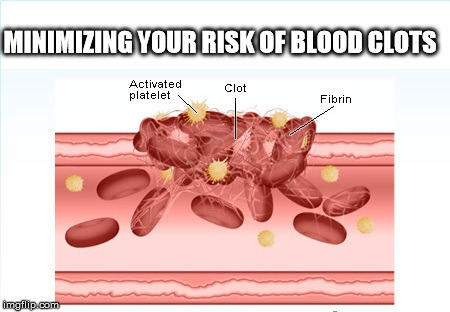Everyone likely recalls former Secretary of State Hilary Clinton’s brush with a blood clot back in December 2012. While her clot was deemed the result of a previous concussion she’d had, there are many reasons that someone could develop a clot anywhere in the body. If not properly treated, a blood clot could result in severe damage to the body and/or death.
For this reason, it is imperative that you do what you can to minimize your risks of clotting. Whether you’ve been diagnosed with an illness that can frequently present clotting such as deep venous thrombosis (DVT), or not, knowing how to prevent and/or minimize clotting of the blood can make all the difference in the longevity of your life.
Understanding a Blood Clot
A blood clot is a natural bodily function. Essentially, it is a buildup of the blood and tissue that can be found inside of the arteries or veins. When you’ve been cut, scrapped, or become injured, the body’s natural way of healing is to form a clot. However, there are instances in which this natural occurrence can be deadly. If the clot creates a blockage, breaks loose and travels to major parts of the body (heart, lungs, or brain), it can result in a stroke, heart attack, embolism, or other medical conditions.
While clotting is more prevalent in those older than 65, it can happen at any age. For those that have already been diagnosed with medical conditions such as those described above, following strict guidelines is the most proactive way to potentially save your life. Below are a few suggestions on how to do this:
1. Watch What You Eat
Foods that are rich in vitamin K are known for helping the blood to thicken increasing the risk of clotting. As such, if you’re prone to clotting or simply want to minimize the chances of it happening to you, then you will want to switch up your diet just a bit. Eating foods that are low in saturated fat and vitamin K are a must. Also, increasing your intake of fiber, fruits and vegetables can help to keep the blood flowing normally.
2. Stay Hydrated
Drinking plenty of water on the daily basis can help to greatly reduce your chances of clotting. Water helps to provide oxygen to the red blood cells which help to improve overall circulation. Not to mention water is also great for releasing toxins from the body as toxins can cause buildups which can lead to clotting. If you have not been drinking the required amount of water on the daily basis (at least 8 glasses) now is the time to do so.
3. Maintain Doctor’s Appointments
Whether you’ve been diagnosed with an illness that is prone to clotting or not, keeping your regular doctor’s appointments is essential to minimizing your risk for clotting. Your doctor’s visits allow you to fully understand what is going on both inside and outside of your body. Early detection of illness prone to clotting can truly make a difference. Also, if a doctor provides you with instructions on how to maintain your health or keep your existing medical condition under control, make sure that you follow that advice to the tee including taking all prescribed medications.
4. Exercise
Idle time can do a lot of damage to the body. Sitting for long periods of time can cause clotting to develop. As such, it is imperative that you incorporate daily exercise into your routine. Exercising doesn’t have to mean going to the gym if that’s not your thing. There are plenty of ways to get moving and keep your health under control. Try something interesting like joining a dance class or even going to play a sport with some of your friends. If you’re looking for something less intense, taking a daily walk or jog through the park will suffice.
5. Invest in Anti-Embolism Products
Medical science and modern technology has certainly afforded us the ability to maintain our health better than ever before. Anti-embolism products are beneficial for those who are prone to clotting. Such products might include anti embolism hose or socks. When wearing such products, consumers will find that there is improved blood circulation. These products are also known to relieve any pain as well as provide the right amount of energy to the legs and feet.
Blood clots, though normal for healing from injuries can become severe and deadly if you’re not careful. While clotting is not something that you want to eliminate altogether, it is something that you want to minimize in instances where clotting is a common occurrence as a result of your preexisting health conditions. Before taking any of the above advice, it is highly recommended that you speak with your doctor or medical professional to ensure that your plan is in fact safe for your overall health.

